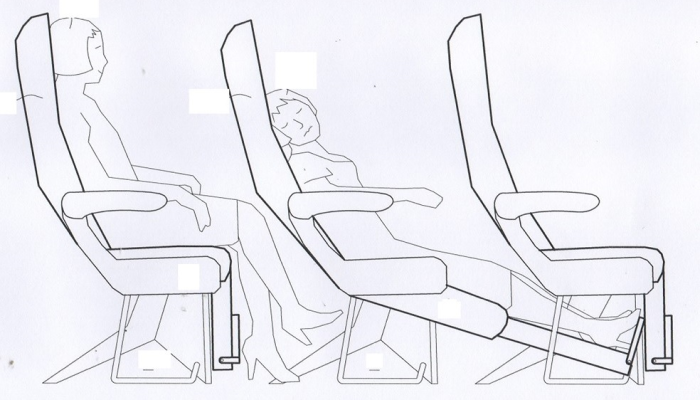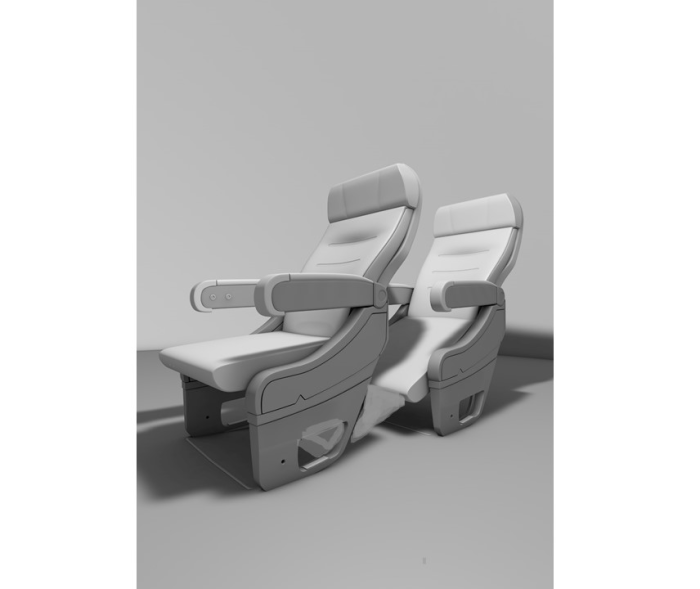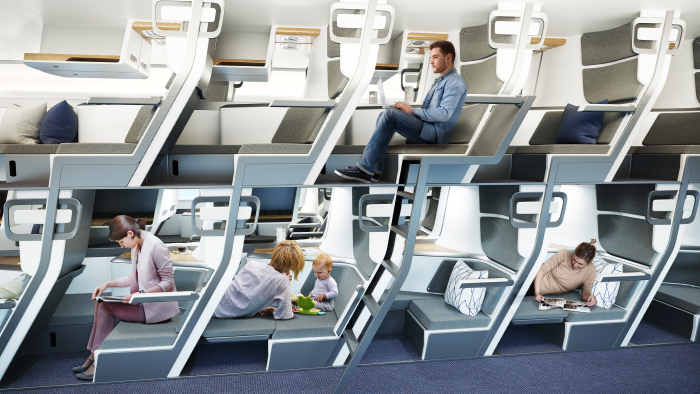Innovations for sitting, sleeping, repeating
This is a special feature from PAX Tech's July Cabin Hygiene, Seating & IFEC 2020 edition.

The LSEAT provides a sleeping position for Economy Class passengers without affecting row pitch, needing electricity or requiring help from crew
As the majority of passengers globally travel in Economy Class, seating suppliers are innovating to increase the passenger experience with front-of-cabin like solutions for airlines at affordable rates for these passengers.
The LSEAT is an Economy Class passenger seat that converts from sitting to sleep mode without the use of electricity or need for crew assistance. The seat cushion moves downward approximately 40 degrees at the front allowing a leg and foot rest to extend, offering a comfortable position for sleep.
The passenger angle of rest is medically and ergonomically proven to be ideal for blood circulation and to avoid inflammation of veins and feet inflight, Yves Hendrickx, LSEAT inventor, tells PAX Tech. The seat was inspired by his personal desire to find an aircraft seat comfortable for both sitting and sleeping and that makes use of the otherwise wasted space below the seat in front.
“Typical recline will only change the inclination of the seat but keep the passenger in sitting mode,” Hendrickx says. The LSEAT, however, extends within in the existing row pitch so that it does not to affect cabin density or disturb surrounding passengers.
Full new installation of the LSEAT can be done overnight. For retrofit solutions, an LSEAT kit is adaptable for many types of seats in order not to alter the integrity of the existing seat. For retrofit, the recline is not modified; the sleep surface comes with the change in shape of the lower seat level and extension below the passenger seat in front. New seats will be available for delivery by May 2021, and retrofit kits for January 2021.
Airlines benefit by being able to offer an improved Economy Class passenger experience – at a higher price point, increasing seat revenue, says Hendrickx. If the airline assumes a US$50 increase per ticket price (for example, but it can be more), with two long-haul rotations per day for 330 days a year, the additional revenue per LSEAT is US$33,000 a year.
“With 48 LSEATs in an Economy Class cabin of 200 seats total, the additional revenue in a year increases by US$1.5 million per aircraft,” Hendrickx explains. “This means the payback time on investment is less than three months.”
 LSEAT rendering
LSEAT rendering
Whether it is long-haul travel for business or leisure, passengers will be willing to pay the minor price increase to know they can sleep inflight, he says. Plus, Hendrickx adds, it’s a reasonable investment that brings high profit in the short term, which is what airlines need to recover from the COVID-19 crisis.
“The Economy Class is carrying the largest number of passengers,” Hendrickx says. “A small revenue increase on the highest number of passengers make the Economy Class the most profitable – far above Economy Plus, Business Class or First Class.”
Hendrickx says Sonaca, hedge and parts provider for companies such as Airbus, Boeing, Embraer and Dassault Aviation, has been named engineering and production subcontractor and management partner. Aerospace service provider Fokker Services is also a possible partner for the LSEAT program.
Since the patent was recently secured, the LSEAT has received high interest from several airlines it has been offered to in Europe, Middle East and Asia.
“The reaction was above our expectations,” Hendrickx says, adding that five major airlines have started purchase negotiations for the seat.
Zephyr double-decker seat
San Francisco-based start-up Zephyr Aerospace has introduced the Zephyr Seat, a double-decker life-flat seat that offers private, comfortable sleep positions for an affordable rate.
Currently in the crowd-funding stage, the Zephyr Seat is undergoing safety tests with engineering partners and requesting Technical Standard Order (TSO) authorization from the Federal Aviation Administration to be commercialized.

The Zephyr lie-flat seat by Zephyr Aerospace
The Premium Economy seat upgrade allows airlines to maintain the industry standard configuration 2-42, but in a stacked bi-level format, Jeffrey O’Neill, Founder and Chief Executive Officer of Zephyr Aerospace, tells PAX Tech in July. Zephyr Aerospace is in discussion with several major airlines but there are no firm customers at this time.
A sleeping position on long-haul flights reduces stress and jet lag and airlines can gradually increase fares and ancillary revenue by offering the lie-flat option in Premium Economy, O’Neill says. And, it encourages physical distancing, offering space for each passenger, he adds.
The price for each Zephyr Seat is up to 50 percent less than a standard lie-flat Business/First Class seat and up to 30 percent lighter. The estimated cost per seat is US$20,000 to $40,000. Each seat has three movable parts – exterior armrest, tray table and footwell cover – reducing direct maintenance costs by up to 75 percent. The retrofit process is estimated to take additional time, given the complexities of second-level seating, he says. Exact costs have not yet been determined.

